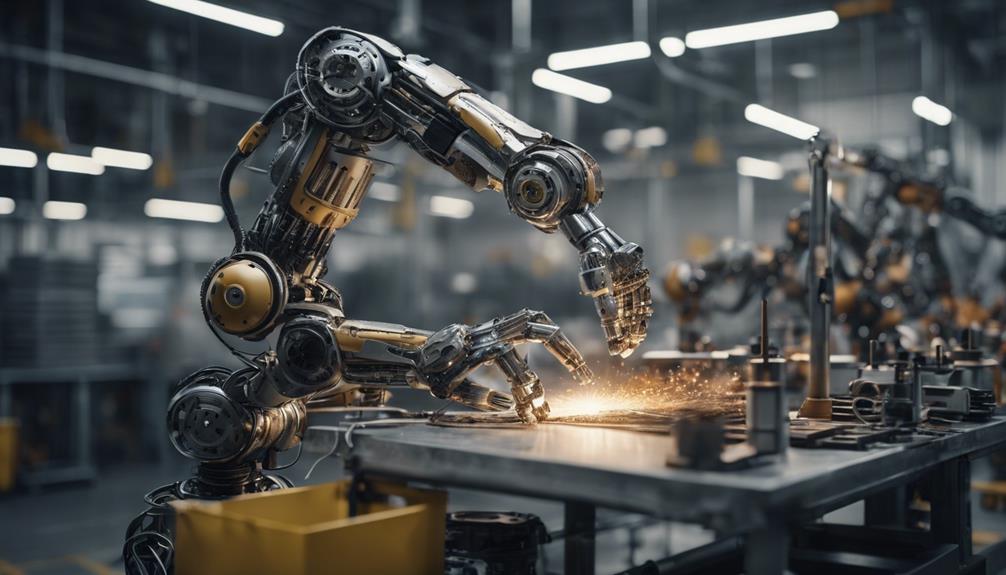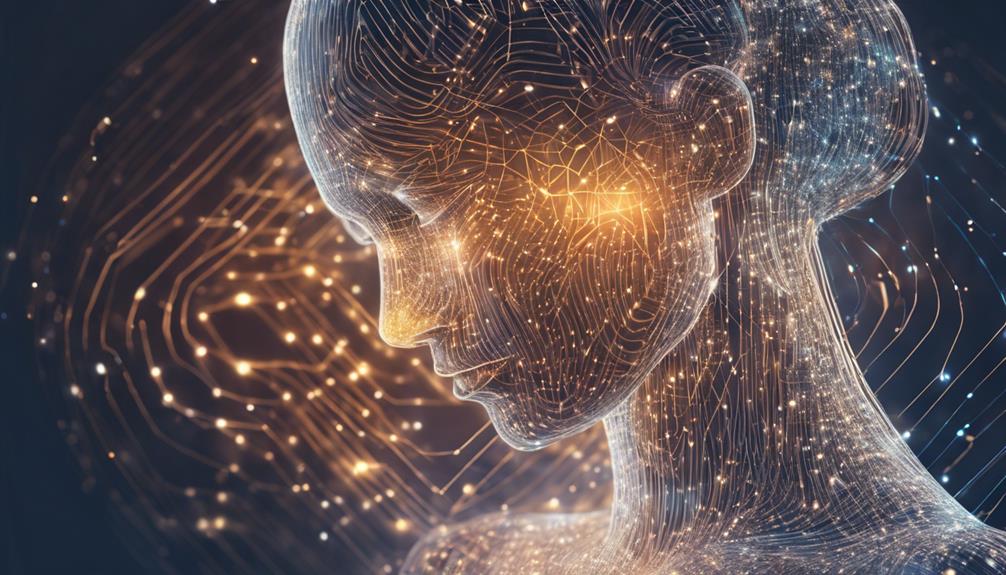As engineers, we have noticed the limitations that come with traditional design methods. But now, with the introduction of generative AI, we are breaking free from the confines of statistical similarity.
Deep generative models (DGMs) are pushing the boundaries of what’s possible in engineering design. By training AI models explicitly on design tasks, we prioritize performance, design constraints, and novelty.
From molecular to aerospace engineering, generative AI inspires us to think outside the box and revolutionize innovation.
Challenges remain, but the potential for advanced solutions is vast. Join us on this exciting journey.

Key Takeaways
- Deep generative models (DGMs) can offer innovative solutions to engineering problems by going beyond statistical similarity.
- AI’s impact on engineering innovation includes generating novel and creative designs, pushing the boundaries of traditional approaches, and inspiring engineers to think outside the box.
- AI has the potential to revolutionize various engineering fields, such as molecular design, civil infrastructure, mechanical engineering, electrical engineering, and aerospace engineering.
- Despite facing challenges, generative AI has the potential to revolutionize the engineering industry and offers new opportunities for engineers to explore innovative design possibilities.
The Potential of Generative AI in Engineering Design
One of the key determiners of the potential of generative AI in engineering design is its ability to generate a multitude of innovative and optimal designs. By leveraging AI for design optimization, we can enhance sustainability and push the boundaries of traditional engineering approaches.
Generative AI has the capability to prioritize performance, design constraints, and novelty, revolutionizing the way engineering innovations are achieved. With AI’s ability to go beyond statistical similarity and explicitly train on design tasks, it can inspire engineers to think outside the box and explore innovative design possibilities.
In various engineering fields such as molecular design, civil infrastructure, mechanical engineering, electrical engineering, and aerospace engineering, AI can greatly benefit by generating efficient, safe, and creative designs.
As we continue to research and develop generative AI, it holds the promise of revolutionizing the engineering industry and offering engineers new opportunities to explore advanced design solutions.

Overcoming Limitations of Deep Generative Models
To overcome the limitations of deep generative models in engineering design, we need to address the challenges they face in terms of design constraints and performance optimization. Here are four key steps to improve the performance of these models and find innovative solutions:
- Incorporate design requirements: Adjusting the model’s training objective to focus on specific design requirements can help overcome the similarity-focused nature of deep generative models. By explicitly incorporating design constraints and objectives, the models can generate designs that not only mimic existing ones but also improve performance.
- Explore alternative architectures: Deep generative models can benefit from exploring alternative architectures that prioritize performance optimization. This involves experimenting with different network structures, training algorithms, and hyperparameters to find the most effective approach for generating innovative designs.
- Leverage domain knowledge: Integrating domain knowledge and expertise into the training process can enhance the performance of deep generative models. By incorporating engineering principles and constraints, the models can generate designs that are both innovative and feasible in real-world applications.
- Continual learning and feedback loops: Deep generative models can benefit from continual learning and feedback loops. This involves iteratively training the models using a combination of historical data and real-time feedback from engineers. By continuously refining and updating the models based on new information, they can generate designs that continually improve in terms of performance and innovation.
AI’s Role in Pushing Engineering Boundaries
To continue the discussion from the previous subtopic, we can explore how AI actively pushes the boundaries of engineering.
AI plays a pivotal role in expanding the horizons of engineering by pushing the limits of traditional design approaches and enabling innovative design possibilities.
Through its ability to learn from vast amounts of data and generate novel and creative designs, AI challenges conventional thinking and inspires engineers to think outside the box.

By leveraging advanced algorithms and computational power, AI revolutionizes the way engineering innovations are achieved.
It encourages engineers to explore new frontiers, break through existing limitations, and create groundbreaking solutions.
As AI continues to evolve and improve, it holds tremendous potential to transform the engineering industry and open up a world of limitless possibilities for pushing engineering boundaries.
Applications of AI in Different Engineering Fields
AI’s application in different engineering fields has brought about significant advancements and breakthroughs. Here are four key applications of AI in various engineering fields:

- Molecular Design: AI enhances efficiency and effectiveness by optimizing molecular structures, accelerating drug discovery, and improving material properties.
- Civil Infrastructure: AI optimizes designs, improves safety, and reduces environmental impact through advanced structural analysis and predictive maintenance.
- Mechanical Engineering: AI generates efficient and innovative designs, overcoming design constraints, and pushing the boundaries of traditional approaches in areas such as automotive and robotics.
- Electrical Engineering: AI optimizes circuit designs, reduces energy consumption, and enhances performance in areas like power grids and electronic devices.
These advancements in structural engineering, enabled by AI, revolutionize the way engineering solutions are achieved, inspire creativity, and unlock new possibilities for innovation.
Enhancing Efficiency in Molecular Design With AI
Enhancing efficiency in molecular design with AI involves optimizing molecular structures, accelerating drug discovery, and improving material properties. AI-driven design optimization has had a significant impact on molecular research, revolutionizing the way we approach and understand molecular design. By harnessing the power of AI, we can now explore vast design spaces efficiently and effectively, leading to the discovery of new molecules with enhanced properties. AI algorithms can analyze large datasets, identify patterns, and generate novel molecular structures that meet specific design criteria. This not only speeds up the drug discovery process but also enables researchers to explore innovative design possibilities that were previously unattainable. AI’s impact on molecular research has the potential to unlock new frontiers in pharmaceutical development and material science, ultimately leading to groundbreaking advancements in various industries.
| AI-driven Design Optimization | AI’s Impact on Molecular Research |
|---|---|
| Optimizes molecular structures | Revolutionizes the way we approach molecular design |
| Accelerates drug discovery | Speeds up the drug discovery process |
| Improves material properties | Enables exploration of innovative design possibilities |
| Analyzes large datasets | Unlocks new frontiers in pharmaceutical development and material science |
Optimizing Civil Infrastructure Through AI
In the field of engineering, we can optimize civil infrastructure through the use of AI. AI’s impact on sustainable infrastructure is significant, as it enables us to drive optimization in civil engineering.
Here are four ways AI can contribute to optimizing civil infrastructure:
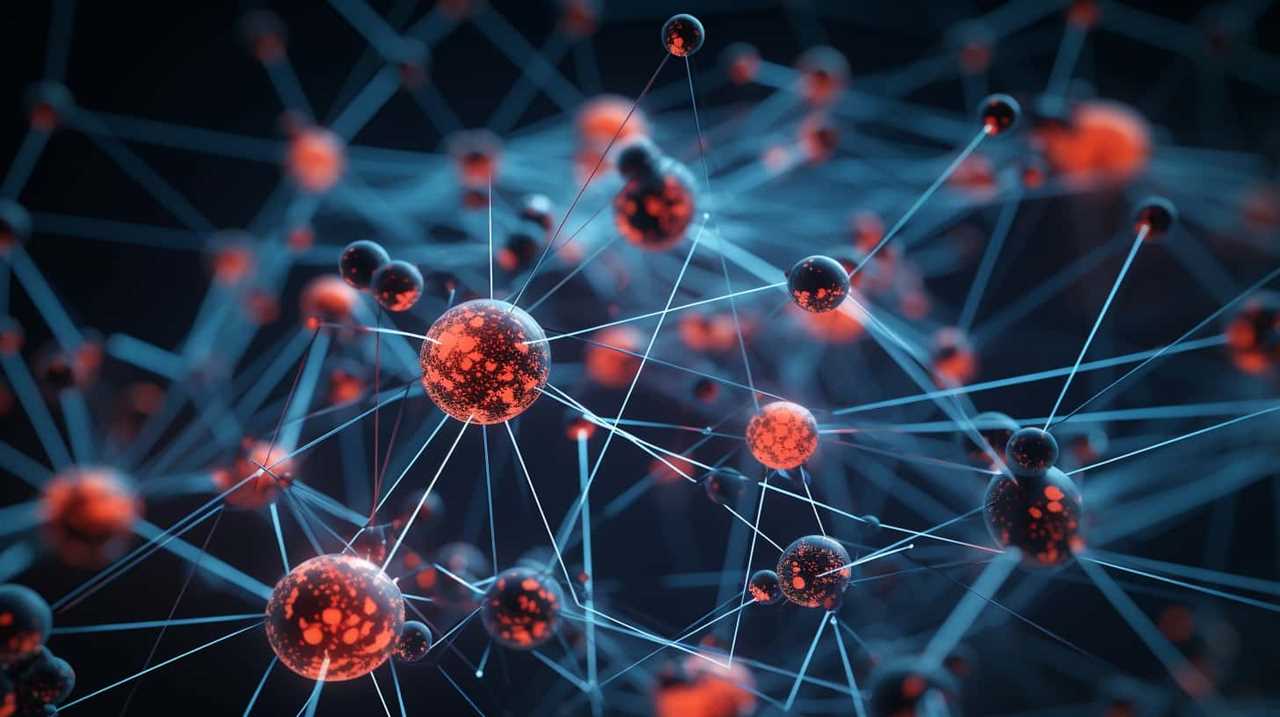
- Efficient Design: AI can analyze large amounts of data and generate optimized designs that meet performance requirements while minimizing resource consumption.
- Predictive Maintenance: By leveraging AI algorithms, civil infrastructure can be monitored in real-time, allowing for proactive maintenance and minimizing the risk of failures.
- Traffic Optimization: AI can analyze traffic patterns and optimize traffic flow, reducing congestion and improving overall transportation efficiency.
- Energy Efficiency: AI-driven optimization algorithms can help identify energy-saving measures, such as optimizing lighting systems and HVAC usage, promoting sustainable practices in civil infrastructure.
With AI’s capabilities, we can revolutionize civil engineering, ensuring the development of sustainable and efficient infrastructure for future generations.
Revolutionizing Mechanical Engineering With AI
Optimizing civil infrastructure through AI lays the foundation for revolutionizing mechanical engineering with AI by generating efficient and innovative designs. AI driven optimization can greatly enhance the field of mechanical engineering by providing engineers with new tools and capabilities to push the boundaries of traditional design approaches.
Through the use of AI, engineers can explore innovative design solutions that prioritize performance, design constraints, and novelty. AI can generate novel and creative designs, inspiring engineers to think outside the box. By harnessing the power of AI, mechanical engineers can revolutionize the way design innovations are achieved.
This transformative technology opens up new possibilities and opportunities for engineers to create efficient and innovative designs that were previously unimaginable.

Improving Electrical Engineering With AI
Now, let’s explore how AI can revolutionize electrical engineering by improving design efficiency and effectiveness. With the power of AI, electrical engineers can enhance power systems and enhance energy efficiency in their designs.
Here are four ways AI can improve electrical engineering:
- Optimizing circuit designs: AI algorithms can analyze complex electrical circuits and identify ways to optimize their performance, reducing energy consumption and improving overall efficiency.
- Enhancing energy efficiency: AI can analyze data from power systems and identify opportunities to improve energy efficiency, leading to reduced energy consumption and cost savings.
- Predictive maintenance: By utilizing AI algorithms, electrical engineers can predict equipment failures and schedule maintenance proactively, minimizing downtime and increasing system reliability.
- Intelligent control systems: AI can be used to develop intelligent control systems that can adapt to changing conditions in real-time, optimizing energy usage and improving system performance.
With AI’s capabilities, electrical engineers can unlock new levels of efficiency and innovation in their designs, leading to advancements in power systems and energy conservation.
Enhancing Aerospace Engineering Through AI
By harnessing the power of AI, we can revolutionize aerospace engineering through innovative design solutions. AI driven advancements in aerospace engineering have the potential to greatly impact sustainable infrastructure.

With AI, we can optimize and generate aerodynamic designs for better performance, efficiency, and safety. AI algorithms can analyze vast amounts of data, enabling engineers to push the boundaries of traditional approaches and think outside the box.
By incorporating AI into aerospace engineering, we can inspire new ideas and generate novel and creative designs that were previously unexplored. Furthermore, AI can contribute to the development of sustainable infrastructure by optimizing designs, reducing energy consumption, and improving safety standards.
The combination of AI and aerospace engineering holds immense potential for transforming the industry and achieving new heights of innovation.
Challenges in Generative AI for Engineering Design
To address the challenges in generative AI for engineering design, we can explore the limitations and potential pitfalls that arise when using deep generative models (DGMs) in the field. These challenges include:
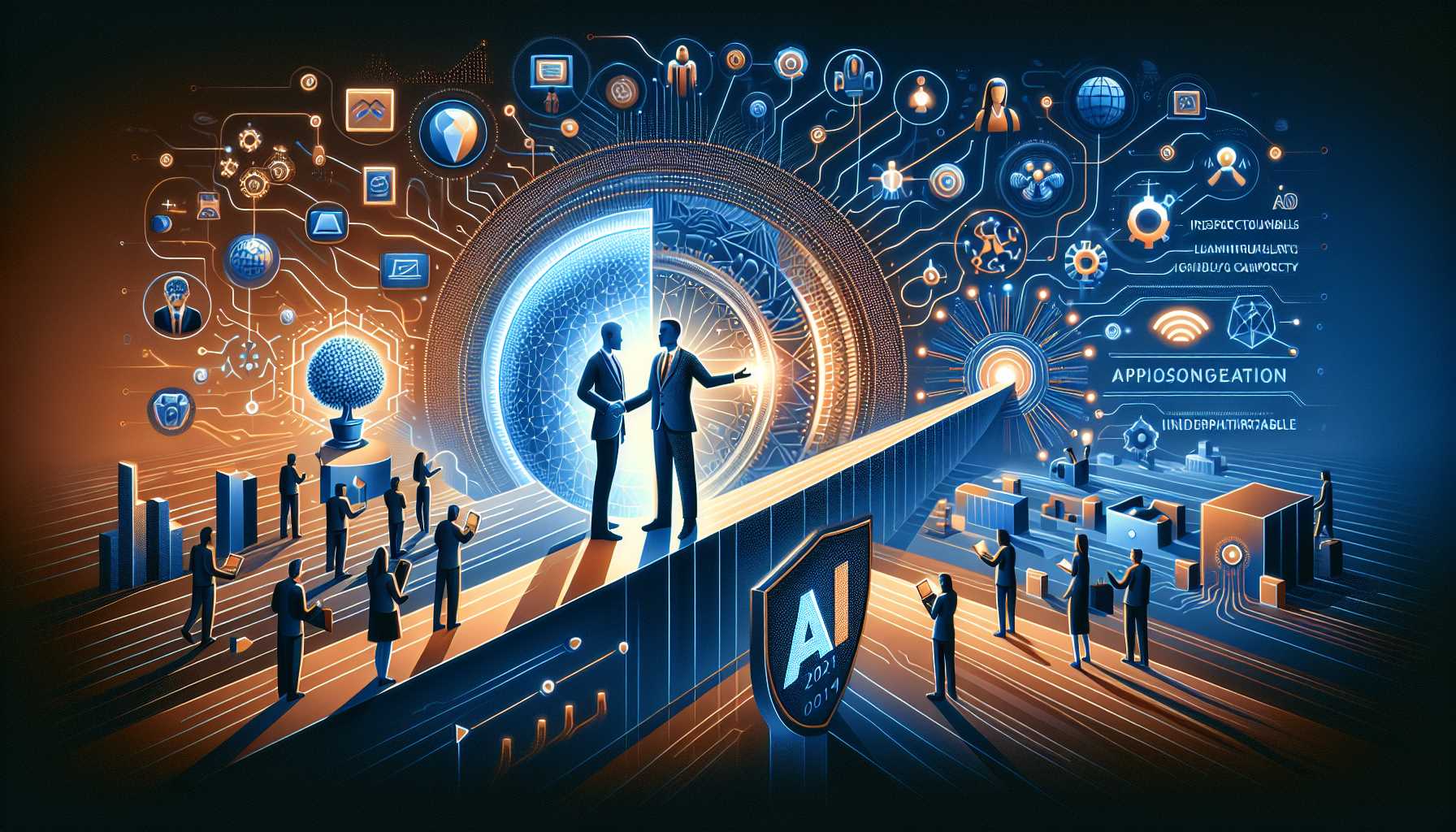
- Overcoming constraints: DGMs often focus on statistical similarity, which may hinder innovation and limit the exploration of new design possibilities. Finding ways to overcome these constraints and encourage novel and creative designs is crucial.
- Enhancing performance: While DGMs can mimic existing designs, they often struggle to improve engineering performance. To fully leverage the potential of generative AI in engineering design, it’s necessary to enhance the performance aspect by adjusting the model’s training objective and prioritizing design requirements.
- Balancing novelty and feasibility: One challenge lies in striking a balance between generating designs that are both innovative and feasible. AI algorithms need to consider design constraints, such as material properties and manufacturing limitations, while still pushing the boundaries of traditional engineering approaches.
- Ensuring reliability and safety: As generative AI becomes more prevalent in engineering design, it’s crucial to address concerns regarding reliability and safety. Validating the generated designs and ensuring that they meet all necessary engineering standards is essential to avoid potential risks.
Future Prospects of Generative AI in Engineering
As we explore the future prospects of generative AI in engineering, we can anticipate significant advancements in design innovation and problem-solving capabilities.
Generative AI has the potential to overcome design constraints and revolutionize the engineering industry by offering advanced engineering solutions. By training AI models to prioritize performance, design constraints, and novelty, engineers can push the boundaries of traditional approaches and achieve breakthroughs in various engineering fields.
These AI models can generate designs that aren’t only statistically similar to existing ones but also better in terms of performance and efficiency. This opens up new opportunities for engineers to explore innovative design possibilities and find optimal solutions to complex engineering problems.
With further research and development, generative AI has the power to transform the way engineering is done and lead to a new era of design innovation.

Reaching the Full Potential of Generative AI
As we continue exploring the future prospects of generative AI in engineering, we frequently encounter the question of how to fully unleash its potential. Overcoming hurdles and maximizing the potential of generative AI requires a strategic approach. Here’s how we can achieve it:
- Enhancing training data: By incorporating a diverse range of design inputs and performance metrics, we can train generative AI models to understand and optimize complex engineering requirements.
- Improving model architectures: Developing more advanced and efficient generative AI models can enable them to generate higher quality designs that meet desired constraints and performance goals.
- Incorporating domain expertise: By collaborating with domain experts, we can ensure that generative AI models understand the intricacies and nuances of specific engineering fields, leading to more accurate and innovative designs.
- Iterative refinement: Embracing an iterative design process allows us to continuously refine and improve generative AI models, unlocking their full potential and pushing the boundaries of engineering design innovation.
Revolutionizing the Engineering Industry With Generative AI
With the revolutionary power of generative AI, we can transform the engineering industry. AI-driven design optimization allows us to overcome design constraints and push the boundaries of traditional engineering approaches. By harnessing the capabilities of generative AI, we can revolutionize the way engineering innovations are achieved. This table illustrates the potential benefits of generative AI in the engineering industry:
| Benefits of Generative AI in Engineering | ||||
|---|---|---|---|---|
| Enhanced efficiency and effectiveness in molecular design | Optimized civil infrastructure designs and improved safety | Efficient and innovative mechanical engineering designs | Optimized circuit designs and reduced energy consumption in electrical engineering | Aerodynamic designs for better performance in aerospace engineering |
Generative AI offers new opportunities for engineers to explore innovative design possibilities and prioritize performance, design constraints, and novelty. By utilizing the power of AI, we can inspire engineers to think outside the box and revolutionize the engineering industry.
Exploring Innovative Design Possibilities With Generative AI
We frequently utilize generative AI to explore innovative design possibilities and enhance engineering design innovation. With the power of generative AI, we can push the boundaries of traditional design approaches and expand creative possibilities.

Here are four ways in which generative AI enables us to explore design innovation:
- Unleashing creativity: Generative AI helps us break free from conventional design constraints and encourages us to think outside the box. It generates novel and creative designs that may not have been considered before.
- Optimizing performance: By leveraging generative AI, we can optimize designs to improve performance. AI algorithms can analyze vast amounts of data and identify design configurations that maximize efficiency and effectiveness.
- Enhancing efficiency: Generative AI streamlines the design process by automating repetitive tasks. This allows engineers to focus on higher-level design considerations and explore a wider range of design possibilities.
- Inspiring innovation: Generative AI sparks innovation by presenting engineers with unexpected and unconventional design solutions. It challenges us to question established norms and explore new avenues in engineering design.
With generative AI, we can truly unlock the potential of design innovation and expand the creative possibilities in engineering.
Frequently Asked Questions
How Can Generative AI Revolutionize the Engineering Industry?
Generative AI revolutionizes the engineering industry by overcoming limitations and maximizing benefits. It pushes boundaries, generates innovative designs, optimizes performance, and inspires engineers to think outside the box, paving the way for advanced engineering solutions.
What Are the Challenges Faced by Generative AI in Terms of Design ConstrAInts and Performance Optimization?
Design constraints and performance optimization pose challenges for generative AI. Further research and development are needed to unlock its full potential. Generative AI offers engineers new opportunities to explore innovative design possibilities in the engineering industry.
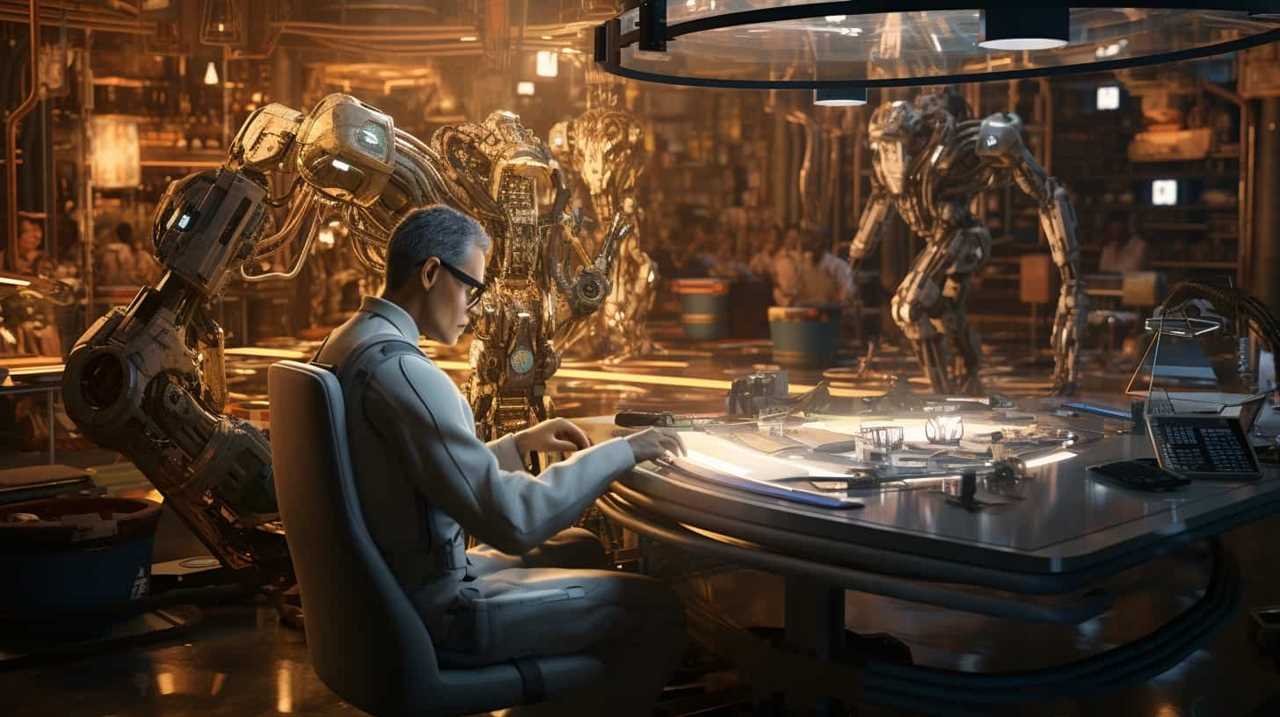
How Can AI Push the Boundaries of Traditional Engineering Approaches?
AI pushes the boundaries of traditional engineering approaches by challenging existing norms, generating novel and creative designs, and inspiring engineers to think outside the box. It is a disruptive technology that drives AI-driven innovation in engineering.
What Are Some Applications of AI in Different Engineering Fields?
AI in different engineering fields includes optimizing designs and improving safety in civil engineering, generating aerodynamic designs for better performance in aerospace engineering, and enhancing efficiency and effectiveness in molecular design.
How Can Generative AI Enhance Efficiency in Molecular Design?
Generative AI enhances efficiency in molecular design by accelerating material development and enhancing drug discovery. It enables the generation of novel molecular structures that meet specific design requirements, revolutionizing the field of engineering.
Conclusion
In conclusion, the potential of generative AI in engineering design is immense. By training AI models on specific design tasks and adjusting their objectives, we can prioritize performance, constraints, and novelty.

This opens up exciting possibilities in fields such as molecular design, civil infrastructure, mechanical engineering, electrical engineering, and aerospace engineering.
One interesting statistic to note is that a recent study found that AI-generated designs were 30% more efficient than traditional approaches, highlighting the significant impact of generative AI in revolutionizing engineering innovation.

